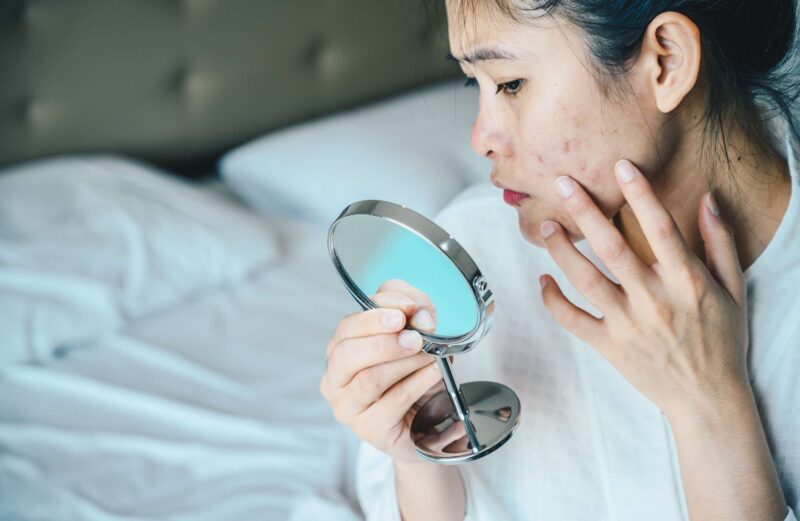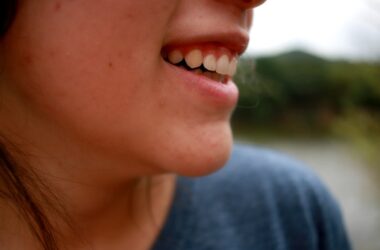Rejuvenating set treats pimples by cleansing deep seated dirt and helps get rid of the bacteria that cause pimples by peeling the dead skin cells. In other words, pimples form when dead skin cells mix with excess oil (sebum). This mixture plugs the pore, causing swelling. Bacteria can grow in the mix and lead to infection and pus. Let’s delve more into how pimples form to get clearer picture.
Table of Contents
Key Points About Pimples
Pimples can develop at any age, but they are more common during the teenage years. They also are more likely to occur during times of hormone level increases, such as pregnancy and menstruation. In addition, pimples most commonly form on the face, neck, back, shoulders, and chest.
Acne is the skin condition responsible for pimples. It has no known cause, but hormonal changes and conditions on and just under the skin’s surface play a role in the formation of pimples. Most commonly, pimples are associated with whiteheads and blackheads.
Foods like chocolate, pizza, and soda have been blamed for causing pimples. Despite popular urban legends, these foods and drinks don’t have any effect on acne. Caring for your skin is a much better way to prevent and treat acne.
Also read: Rosmar Kagayaku Bleaching Whipped Soap
What are the different types?
The most common type of acne is called acne vulgaris. This very common skin condition affects 70 to 87 percent of teenagers. It can cause acne your entire life.
Acne vulgaris manifests as various types of skin blemishes, including whiteheads, blackheads, papules, and pustules.
Whitehead
A whitehead is a type of acne that isn’t inflamed. Whiteheads occur when skin cells, oil, and bacteria combine to create a white tip of oil-skin mixture. A whitehead looks like a small pimple, but the area around it will not be inflamed and red.
Blackhead
Blackheads are also not inflamed. They form when the plug that clogs the pore sits at the top surface of the skin. This “plug” isn’t necessarily black, but it appears that way, which is why they are called blackheads. Blackheads are not dirt stuck in your pores.
Pustules and papules
A pimple is a clogged pore that has become infected. The infection makes a white pus-filled tip on top of the affected pore. The area around the infected pore can become inflamed, red, and sensitive.
How do pimples form?
Your skin is covered in millions of tiny little wells, or pores, that sit at your hair follicles. Pores connect the surface of your skin to an underlying gland called the sebaceous gland. This gland produces an oily substance called sebum. Sebum is released continually, in small amounts, into the hair follicles and skin. Dead skin cells are also carried up with the sebum so they can be washed away.
Occasionally, the sebaceous gland produces too much sebum. The overflow of oil can clog the pore. The excess oil and dead skin cells form a plug in the gland. This pore becomes clogged with sebum, oil, and possibly bacteria. The bacteria can multiply. These bacteria can lead to an infection, swelling, and inflammation around the clogged pore. A white tip of pus will sometimes form at the top of the clogged pore. This creates a pimple.
Pustules and papules
Sometimes clogged pores become so inflamed and infected that they burst through their walls. This causes the infection to spread, which leads to a bigger pimple. These pimples are called pustules and papules.
Papules are hard to the touch. They make the skin feel very rough and ragged. Pustules are filled with a yellow-tinted pus. Pustules look more like blisters on the skin than typical whiteheads.
Nodules and cysts
Blocked pores can lead to an even bigger infection called a nodule. Nodules sit deep in your skin. They are often very painful and sore. Cysts are large like nodules, but they are softer because they are filled with pus.
What should I do if I have a pimple?
First things first: Don’t pop the pimple. This will allow more bacteria, dirt, and oil into the pore, which may end up making the pimple worse.
Instead, use good skin care techniques. Wash your skin twice a day with a mild soap. Don’t use a brush or washcloth. Use your fingers instead. Then, you can use skin rejuvenating set to help the pimples clear.
What if my acne is nodular or cystic?
These types of acne are more difficult to treat. It’s best for you to make an appointment to see a dermatologist. A dermatologist is a type of doctor that specializes in treating skin conditions like acne.
What if I have a whitehead?
Don’t pop whiteheads. You might cause a bigger breakout if you do. Treat whiteheads the way you do other kinds of pimples. Wash your face twice a day with a mild soap. Then, you can use skin rejuvenating set to help the whiteheads clear.
These products help whiteheads clear up, and they can also prevent future breakouts. In particular, rejuvenating set helps get rid of bacteria. Which can lower your chances of whiteheads, blackheads, and pimples altogether.
What if I have a blackhead?
You shouldn’t pop or scrape blackheads, either. Your skin needs time to heal naturally. Washing your face daily is important to prevent blackheads. Treating blackheads, however, may require a bit more work.
Rejuvenating set also works to reduce oil production, kill bacteria, dry excess oil, and speed up skin cell turnover.
If these treatments aren’t successful, see a dermatologist about additional treatment options. Prescription medications as well as in-office treatments like microdermabrasion and chemical peels may be an option for some people.
Although it’s important to eat healthfully, occasional snacking isn’t going to cause your skin to break out. If you do break out, you shouldn’t pick, scrape, or pop the blemish. This can amplify any irritation and inflammation.
Use rejuvenating set to treat pimples
Of course you can use rejuvenating set to treat pimples. Especially, if you have a pimple that just won’t heal or are experiencing regular breakouts. Another option is you may want to speak with your doctor or dermatologist. They can help you determine the best treatment plan for you. If the rejuvenating set option has been unsuccessful, they may recommend an in-office treatment or prescription medication to help clear your acne. However, we have dealt with many cases in which using rejuvenating set was even a more successful experience than visiting a dermatologist. If you need further advise, don’t hesitate to contact us or drop a comment below.
Read More: In Video: What is Skin Rejuvenating Set And Tips On Using it?




